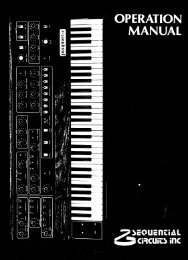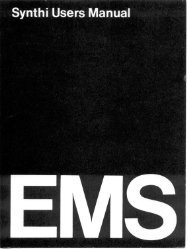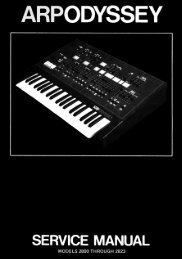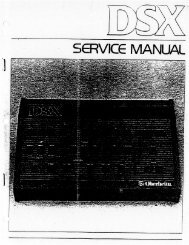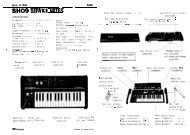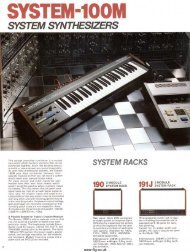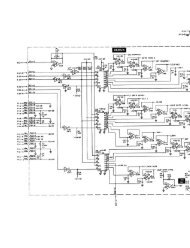ARP2600 - Fundamentals of Music Technology - Cyborgstudio.com
ARP2600 - Fundamentals of Music Technology - Cyborgstudio.com
ARP2600 - Fundamentals of Music Technology - Cyborgstudio.com
You also want an ePaper? Increase the reach of your titles
YUMPU automatically turns print PDFs into web optimized ePapers that Google loves.
086 - SECTION ELEVEN: PREAMP, ENVELOPE FOLLOWER, RING MODULATORAlthough the ring modulator is incredibly <strong>com</strong>plex, some generalizations can be made about the kinds<strong>of</strong> sounds which can be produced with it. Metallic instruments naturally have a very dense harmoniccontent, and as such, the ring modulator does an amiable job <strong>of</strong> imitating them. CD track 61 It is alsogood at accentuating the high frequencies <strong>of</strong> different timbres, and can be a highly effective addition toa patch. CD track 62 Another interesting effect can be achieved by using one VCO in LF mode whilethe other is in audio mode. If a square wave from the LFO is used, a pleasant pulsing effect can becreated. CD track 63The ring modulator’s output is normalled to both the VCF and the VCA. While its presence in the VCFis no surprise, the fact that it is normalled to the VCA is a little unusual. Certainly the VCF should benormalled to the VCA, since that is the normal signal flow in the most <strong>com</strong>mon synthesizer patch.However, out <strong>of</strong> all <strong>of</strong> the modules present on the 2600, one is left to wonder why the ARP’s designer’schose to normal the ring modulator to this input. Perhaps it was chosen by default; the VCF was alreadynormalled to the VCA, and choosing a VCO would mean selecting one above the remaining two. Otherthan the ring modulator, there are few other sound-producing modules. One can almost imagine the2600’s designers pondering a choice between the noise generator and the ring modulator...THE DC/AUDIO SWITCHNear the bottom <strong>of</strong> the ring modulator, between its inputslies a switch labeled AUDIO and DC. This switchdetermines whether the ring modulator’s inputs are ACor DC coupled. It is not as important to understand theissues <strong>of</strong> AC and DC coupling as to understand thechanges each setting brings about in the ring modulator’soperation.When the ring modulator is AC coupled (the switch is in the AUDIO position) any direct current (DC)in the signals is cancelled out before it reaches the modulator circuit. Another way to say this is that thein<strong>com</strong>ing waveform’s voltage <strong>of</strong>fset will be raised or10Vlowered so that the waveform’s average height is zerovolts. In Figure 11-9, one can see a saw wave as it0Vwould be produced by VCO-1. When the saw wavehits the AC coupling circuit, it is changed to look likeFigure 11-10. Its average is now 0 volts instead <strong>of</strong> +5-10VFigure 11-10: A saw wave which is AC coupled volts.If the switch is set to the DC position, the circuit is DC coupled and waveforms are passed into the ringmodulation circuit ‘as is.’ The change in sound between these two settings is difficult to describe, but itwould be generally accurate to say that sounds using the DC position are more clangorous and have aneven greater level <strong>of</strong> <strong>com</strong>plexity than those generated in the AUDIO position. Listen to a few soundswhich start with the switch in the audio position, then move it to the DC position. CD track 6410V0VFigure 11-9: a standard in<strong>com</strong>ing saw wave




